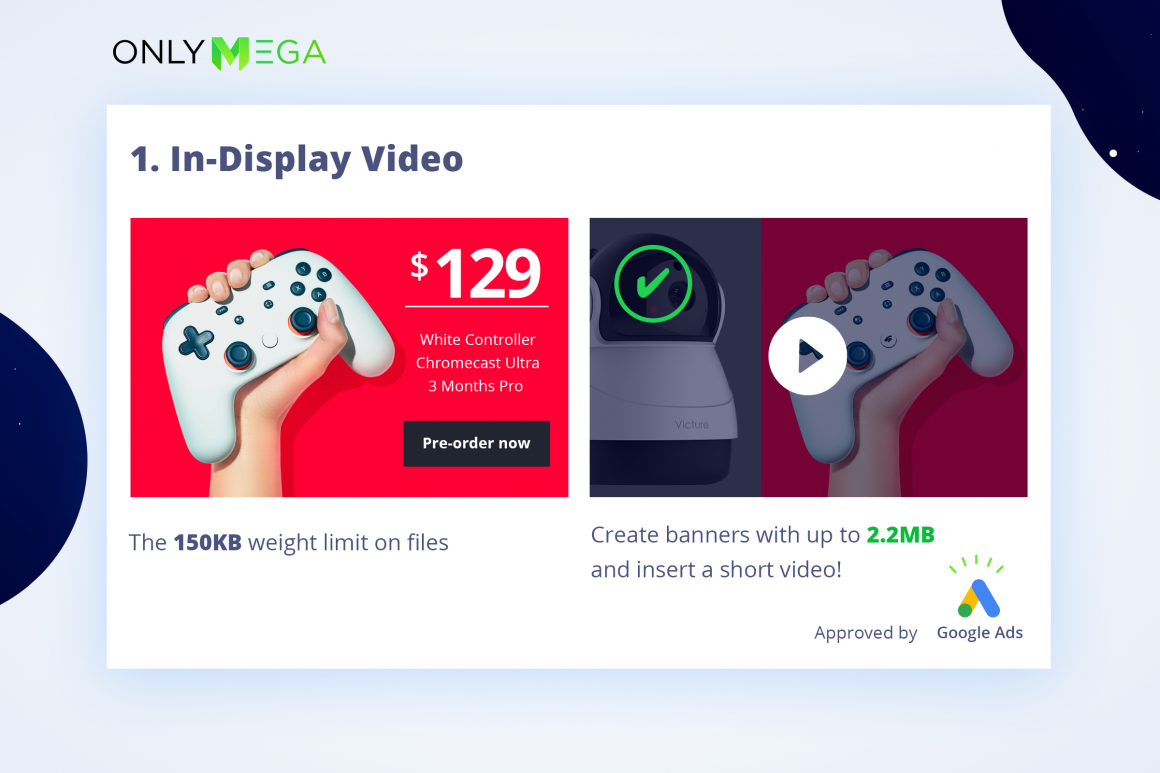Shhh, in this article, we’re going to share a little secret (or four and some more) about some of the hidden features, nobody has told you about within the Google Display Ads platform. Big corporations have been utilizing these hidden features for years now, and it’s safe to bet that their ad campaigns are performing far more efficiently than yours. We’re going to help fix that.
But first, let’s get into some of Google’s not-so-secret restrictions as per ad sizing, techs, and specs, which you can read more about here. And hey, you’d be surprised to know that we’ve found a couple of loopholes for some of these. Let’s get into it!
A Quick Look into Some of Google’s Restrictions
It’s no news that Google applies some strict restrictions for display ads, such as:
- The 150KB weight limit on files.
- No video allowed.
- Animations lasting up to 30s.
- No mouse interactions allowed.
- No third-party retargeting.
But First, Discover Third-Party Ad Serving Certified Vendors
In order to move forward into the 4 secret features, you need to learn about third-party certified vendors. What does this mean? This means that there are many certified Google vendors, and each of these has different certifications, which allow them to carry out certain tasks.
For example, you’ll find vendors that are only certified for analytics research, others for Ad Swapping and so on.
However, in this case, we are interested in Ad Server Advertiser certified vendors. Like BannerNow which is a certified Ad Server Vendor and has many possibilities to offer in terms of ad creation.
Technicalities of Using BannerNow Certified Google Vendor
Even if utilizing a third-party vendor, there are still certain rules that will abide by Google Ad Policies. Here are a couple of explanations to keep in mind when creating your next customized banner:
Sizing, Techs & Specs: Some of the perks of using BannerNow is that it permits a total non-user initiated load size of up to 2.2 MB, which escapes Google’s 150KB limit.
The limit will always be 2.2 MB for all HTML5 assets including video, custom fonts, polite loading fallback. In this case, true streaming is not counted within the 2.2MB limit.
Video (In-Display Ads): Remember that FLV video format is not permitted. If you were to implement video, both MP4, and either WebM or Ogg formats must be used to ensure compatibility across all major browsers. On the other hand, autoplay, animations are limited to 30 seconds (which includes loops).
Mouseover: Only user-initiated mouse effects (by hover or click) are allowed for banner ads and will always be in control by the user. These effects can turn the mouse into a different pointer design and/or animate portions of the ad. Note that sound effects are not permitted in mouseover/rollover.
- No sound is permitted, only on click. User-initiated videos on click only as well.
Remember that the video needs to be muted by default. Sound is only allowed only in the case that the user clicks on the unmute button on the banner.
- The video must include: A progress bar, play/pause/stop buttons and mute/unmute buttons.
- Actions on use click: All sound must come to a stop upon exit click.
4 Secret Google Display Ads Features
So now that we’ve covered some of the restrictions as well as our chosen third-party vendor to utilize, it’s time to learn about some of the loopholes we’ve come to find.
We’re going to take a look into these 4 Google Display Ads Features you didn’t know about:
- In-Display Video
- Dynamic Live Data
- Input Fields & Custom Mouse Interactions
- Dynamic Retargeting.
The first sneak peek: It is actually a possibility to create ads bigger than 150KB, in-display videos, mouse interactions, input fields, live data and dynamic retargeting.
How so? Well, this brings us to our list of secrets…
Creating Banners in BannerNow with each of the Hidden Features.
1. In-Display Video
If you’re looking to create in-display videos on the BannerNow platform, we can teach you exactly how. Especially now that it’s possible to create banners with up to 2.2MB in size, you can insert a short video into your banner!

This is how this goes:
- Upload your video into the BannerNow media page in the following formats: MP4, Ogg, WebM. This will ensure browser compatibility. Remember that MP4 is the most supported across devices.
- Open the BannerNow editor, drag your video, enable autoplay and mute sound. Remember that the mute feature for autoplay is required by Google Ad Policies.
- Save the banner.
Results? A banner weighing 2MB with a video included, which can successfully be uploaded to Google Ads. Talk about amazing!
2. Dynamic Live Data
If you own any type of e-commerce store, it’s important to always be updating the information in your banners. This refers to users that may be clicking on a static banner when the product has sold-out or is no longer available. It’s important to keep track of your promotions, sales, and products being advertised. However, keeping them manually updated every time a change occurs, can be annoying, to say the least…
However, this takes us into our second hidden feature which is Dynamic Live Data. Yes! There’s now an easy way to keep your banners automatically updated.
But, how?

Well, this is done by connecting live data to your banners. This may already sound complicated, but no worries and go for it! Here are the step by step instructions:
- Use a basic e-commerce JSON or XML feed. Copy the JSON or XML feed URL from your website (most e-commerce sites offer feeds) and insert this feed URL into BannerNow.
- Select the data that will be used in your banner and apply filters such as “products by price”.
- Create a new banner and connect each item (text, button, hyperlink image) into the feed.
- Save and preview.
Now, it may not be what you’re thinking. This does not refer to the feeds used to upload via FTP to your Google ads, that then connect to dynamic banners created in Google Web Designer. This is a whole other story.
Once you’re through with the steps… Voilá! You now have a banner connected with live data. Every now and then, the data in your e-commerce feed will be updated as per any event (sold-out items, unavailability for a service, etc).
BannerNow will automatically pull the date from your feed every several minutes and will automatically update all ads connected to this feed. What a relief! You won’t need to update banners manually each time. Talk about a time saver.
3. Input Fields and Mouse Interactions
Imagine you are a travel agency wanting to showcase different destinations, trips and travel deals to different users based on their budget. This will get you thinking: How can I make this happen if my audience is only able to click on the banner? How would I be able to segment this by personal budget?
Here’s another secret solution for you: It’s possible to create a custom widget with input fields that will connect to your data feed.

We’ll show you the way:
- Open up BannerNow- Create a widget with a price range slider.
- Open up the editor, drag and drop this widget into your banner.
- Save and preview.
By creating this banner with the input widget such as the price range slider in this example. You’ll allow users to select their desired budgets and filter products/destinations directly from the banner. When dragging the slider, the banner will automatically retrieve filtered data from the feed and display the product that fits their budget directly inside the ad. Once the user clicks on the CTA button, they will be redirected to your landing page URL, which will also be retrieved from the feed.
When widgets are used, like in this case, it is possible to control the areas that will be “clickable” and interactive for the user, with different input fields.
But Wait, How do I Upload Custom Banners into Google Ads?
Ah, the million dollar question, right? We taught you how to create these super amazing custom banners, but how can they be published into Google Ads?
Very simple:
- Click on the “publish” button within BannerNow and select the “Goole Display Network” option.
- Click on download as .xlsx (Excel file)
- Open the excel file and fill in the ad groups and campaigns where these banners need to be published.
- If you have a Managed Adwords account, submit your .xlsx file with the ad tags here: https://support.google.com/adwords/troubleshooter/6162023 Tag type: Ad Tag. Ad Status: Live or Paused (the purpose of this gives you the option to manually start the ads from your personal AdWords account).
- You’ll end up with 1 attachment which contains ad tags and the mapping instructions.
- Select the .xlsx file that was downloaded from BannerNow.
- Have you attached any necessary tags or other required documents? Choose: “Yes”.
- If you have an Unmanaged Adwords account, submit your .xlsx file with the ad tags included here: https://developers.google.com/third-party-ads/googleads-vendors
And that’s it! The banners you created will be visible in your Google Ads campaigns. All you need to do now is check how your CTR will double in little time because of the unique ads you’ll be serving. Oh, and let’s not get into the competition, because you’ll be crushing it!
4. Last but not Least: Dynamic Remarketing with Customized Ads
So what if you want to go for dynamic retargeting on your ads? How would you pass on the product ID’s to the banner so that it displays the correct product after the user has visited the website?
In this case, you’ll need an additional third-party provider such as Adamatic, which can publish your ads to the Google Display Network without the use of Google Ads.
In a nutshell, this is how this would work:
- Install a tracking script on your website. This will track which products users were once interested in.
- Create a banner in BannerNow and connect them to your e-commerce feed.
- Send the banner tags to Adamatic.
- And done! Once the user visits a site connected to AdSense or the Google Display Network, Adamatic will display your banner and will transfer product ID’s that this user viewed on your website earlier. The banner will display these products to the user. In other words, this is remarketing.
Some Examples of Rich Media Ads to Get You Going:
You can get inspired by various media ads within the Rich Media Gallery.
Even take a look into some of the slider rich media ads that have been created here: http://www.richmediagallery.com/detail?id=8052
Don’t Sweat it, Give it a Try!
Sure, some of the points discussed in this article may seem a bit complicated at first. Our advice? Contact these third-party providers directly and they’ll be happy to teach you how this stuff works. But all in all, we hope this information will open doors for your brand into creating different types of media and ads which will skyrocket your CTR!
And remember, if you have any questions, don’t hesitate to shoot us your questions. We are happy to help out. Good luck!











